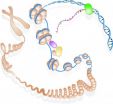(Press-News.org) If you end up with a rash on a new tattoo, you should probably think twice before brushing it off as an allergic reaction or a normal part of the healing process.
A recent study in the New England Journal of Medicine documents 19 cases in the Rochester, N.Y., area – the largest ever reported – of tattoos infected with a type of bacteria often found in tap water. Evidence points to a premixed gray ink, the type used in currently popular portrait or photography tattoos, as the culprit.
Mary Gail Mercurio, M.D., a dermatologist at the University of Rochester Medical Center, saw 18 of the 19 individuals infected. She says some people with tattoos have allergies or experience other dermatologic complications, but it's not common. "I've seen people with tattoo-related issues over the years, but never this many: The volume of patients impacted makes this a real public health concern.
"Patients and doctors need to have a certain level of suspicion when they see a rash developing in a tattoo. Many of the patients I saw thought their skin was just irritated and the issue would go away during the healing process. In actuality, they had an infection that needed to be treated with an antibiotic; it wasn't going to go away easily on its own."
The investigation of the outbreak, which was also highlighted in the U.S. Centers for Disease Control and Prevention's Morbidity and Mortality Weekly Report, started with a previously healthy 20-year-old man who had a history of multiple tattoos in the past without any issues. In October 2011, he received a new tattoo on his arm and subsequently developed a persistent, inflamed rash in that area. After learning of his case, the Monroe County Department of Public Health explored the issue and identified 18 other individuals who developed similar rashes after getting tattoos at the same parlor, from the same artist.
Tests conducted at the Medical Center revealed that a specific type of bacteria, Mycobacterium chelonae, was in the patients' skin and led to the red, itchy bumps in their tattoos. Further testing found that a premixed gray ink, which the local artist had bought from a manufacturer in Arizona, contained the same bacteria and likely transmitted it to the skin.
Robert F. Betts, M.D., a long-time infectious disease expert at the Medical Center who treated almost all of the patients, confirmed that the infection was only in the areas tattooed with the gray ink. Also called gray wash, it is used to achieve shading and a three-dimensional quality in tattoos.
According to the local tattoo artist, the manufacturer diluted black ink with distilled water to create a gray color. "This organism, M. chelonae, is found in some water supplies," said Betts. "What probably happened is that the water used to dilute the ink introduced the bacteria into it and the trauma associated with getting the tattoo compromised the circulation to that area of the skin, allowing the organism to enter into the skin and grow."
Betts says that this species of bacteria grows best at around 86 °F, a little bit below normal body temperature, which is approximately 98.6 °F. The skin is cooler than the rest of the body, which may explain why the bacteria flourished in the tattooed areas.
Following the investigation, the CDC issued a nationwide alert about the outbreak and the manufacturer voluntarily recalled the ink. Betts evaluated and treated 16 of the 19 patients with standard antibiotics – azithromycin and doxycycline – and everyone improved, although at different speeds based on the extent of the infection.
Both Betts and Mercurio believe that tattoo-associated infections are probably more common than we think and that physicians should think about infectious causes if patients aren't responding to topical or other dermatologic treatments that would typically dispel any sort of allergic reaction to a tattoo.
###In addition to Betts and Mercurio, Glynis A. Scott, M.D., Matthew A. Lewis, M.D., and Mark H. Goldgeier, M.D., from the Medical Center contributed to the research. Byron S. Kennedy, M.D., Ph.D., from the Monroe County Department of Public Health was the lead author of the New England Journal of Medicine study. Physicians and scientists from the New York State Department of Health, the CDC and the FDA participated in the research as well.
In Rochester, a tale of tainted tattoos
Local outbreak highlights new source of infection – tattoo ink
2012-09-06
ELSE PRESS RELEASES FROM THIS DATE:
Deep-sea crabs seek food using ultraviolet vision
2012-09-06
HOLLYWOOD Fla. — Some deep-sea crabs have eyes sensitive to ultraviolet light, which they may use to snatch glowing plankton and stuff it in their mouths, a new Nova Southeastern University study suggests.
Tamara Frank, Ph.D., a marine biologist and associate professor at Nova Southeastern University's Oceanographic Center, who is the principal investigator of the study, said that crabs living the deep-sea zone --- a pitch dark area at the ocean bottom ---- may be using bioluminescence to help sort out their food.
Duke University marine biologist Sönke Johnsen. Ph.D., ...
CNIO participates in the ENCODE project: A stride forward in biomedical research
2012-09-06
The international Encode project, a collaborative study bringing together hundred of scientists from all round the world, including researchers working at the Spanish National Cancer Research Centre (CNIO), published results yesterday mapping the control and regulation of genome activity. These results indicate a total of four million 'switches' controlling the gene activity of 147 types of human cells and tissue. This map provides us with the first comprehensive vision of the genome as a complex web of interactions, and goes far beyond our initial thinking, which assigned ...
Urban Real Estate Development Firm Launches Digital Brand
2012-09-06
With the impending completion of redevelopment on 1 & 7 Ionia and another property closing in downtown Grand Rapids, Michigan, soon to be announced, urban real estate development firm 616 Development is establishing its brand in the digital space. The company's new website, 616Development.com, offers detailed insights into the company's founding, its core members, key development projects and its unique approach to urban development. Alongside engagement in prominent social networks, the website lays the foundation for the brand's voice in both digital and non-digital ...
Picky penguins: Does mate choice depend on genes that help resist disease?
2012-09-06
NEWPORT, Ore. – Magellanic penguins have a high level of variation in genes associated with the ability to fight infectious disease, but a recent study found that the mechanism the penguins use to ensure that diversity is far from black and white.
Found exclusively south of the equator in South America, Magellanic penguins assemble in large nesting colonies along the coasts of Argentina, Chile, and the Falkland Islands. They typically mate for life, producing clutches of two eggs that are cared for by both parents. While individual colonies can number in the millions ...
NFL players may be at higher risk of death from Alzheimer's and ALS
2012-09-06
MINNEAPOLIS – New research shows that professional football players may be at a higher risk of death from diseases that damage the cells in the brain, such as Alzheimer's disease and ALS (also known as Lou Gehrig's disease), compared to the general U.S. population. The study is published in the September 5, 2012, online issue of Neurology®, the medical journal of the American Academy of Neurology.
The study included 3,439 players with an average age of 57 from the National Football League with at least five playing seasons from 1959-1988. Researchers reviewed death ...
The best strategy to defeat HIV in South Africa
2012-09-06
The World Health Organization is about to roll out a new strategy for AIDS prevention in South Africa, a country where more than 5 million people are infected with HIV. Based on a mathematical model, the WHO predicts this strategy will completely eliminate HIV in South Africa within a decade.
But not so fast, suggests a group of UCLA researchers. Their work challenges the proposed strategy by showing it could lead to several million individuals developing drug-resistant strains of HIV. And further, they say, it will cost billions of dollars more than the WHO has estimated. ...
Study in mice suggests sleep problems may be early sign of Alzheimer's
2012-09-06
Sleep disruptions may be among the earliest indicators of Alzheimer's disease, scientists at Washington University School of Medicine in St. Louis report Sept. 5 in Science Translational Medicine.
Working in a mouse model, the researchers found that when the first signs of Alzheimer's plaques appear in the brain, the normal sleep-wake cycle is significantly disrupted.
"If sleep abnormalities begin this early in the course of human Alzheimer's disease, those changes could provide us with an easily detectable sign of pathology," says senior author David M. Holtzman, MD, ...
Animal study finds anti-HIV vaginal ring can prevent virus transmission
2012-09-06
Population Council scientists have found that a vaginal ring releasing an anti-HIV drug can prevent the transmission of SHIV in macaques. This study provides the first efficacy data on the delivery of a microbicide from a vaginal ring, and indicates strong potential for the success of such rings in women. Microbicides are compounds that can be applied inside the vagina or rectum to protect against sexually transmitted infections (STIs), including HIV.
"This proof-of-concept study confirms that the investment in vaginal rings as a delivery system for HIV prevention is ...
Researchers unlock disease information hidden in genome's control circuitry
2012-09-06
Researchers at the University of Washington have determined that the majority of genetic changes associated with more than 400 common diseases and clinical traits affect the genome's regulatory circuitry. These are the regions of DNA that contain instructions dictating when and where genes are switched on or off. Most of these changes affect circuits that are active during early human development, when body tissues are most vulnerable.
By creating extensive blueprints of the control circuitry, the research also exposed previously hidden connections between different ...
Fast forward for biomedical research: ENCODE scraps the junk
2012-09-06
The hundreds of researchers working on the ENCODE project have revealed that much of what has been called 'junk DNA' in the human genome is actually a massive control panel with millions of switches regulating the activity of our genes. Without these switches, genes would not work – and mutations in these regions might lead to human disease. The new information delivered by ENCODE is so comprehensive and complex that it has given rise to a new publishing model in which electronic documents and datasets are interconnected.
Just as the Human Genome Project revolutionised ...
LAST 30 PRESS RELEASES:
Sleeping in on weekends may help boost teens’ mental health
Study: Teens use cellphones for an hour a day at school
After more than two years of war, Palestinian children are hungry, denied education and “like the living dead”
The untold story of life with Prader-Willi syndrome - according to the siblings who live it
How the parasite that ‘gave up sex’ found more hosts – and why its victory won’t last
When is it time to jump? The boiling frog problem of AI use in physics education
Twitter data reveals partisan divide in understanding why pollen season's getting worse
AI is quick but risky for updating old software
Revolutionizing biosecurity: new multi-omics framework to transform invasive species management
From ancient herb to modern medicine: new review unveils the multi-targeted healing potential of Borago officinalis
Building a global scientific community: Biological Diversity Journal announces dual recruitment of Editorial Board and Youth Editorial Board members
Microbes that break down antibiotics help protect ecosystems under drug pollution
Smart biochar that remembers pollutants offers a new way to clean water and recycle biomass
Rice genes matter more than domestication in shaping plant microbiomes
Ticking time bomb: Some farmers report as many as 70 tick encounters over a 6-month period
Turning garden and crop waste into plastics
Scientists discover ‘platypus galaxies’ in the early universe
Seeing thyroid cancer in a new light: when AI meets label-free imaging in the operating room
Neutrophil-to-lymphocyte ratio may aid risk stratification in depressive disorder
2026 Seismological Society of America Annual Meeting
AI-powered ECG analysis offers promising path for early detection of chronic obstructive pulmonary disease, says Mount Sinai researchers
GIMM uncovers flaws in lab-grown heart cells and paves the way for improved treatments
Cracking the evolutionary code of sleep
Medications could help the aging brain cope with surgery, memory impairment
Back pain linked to worse sleep years later in men over 65, according to study
CDC urges ‘shared decision-making’ on some childhood vaccines; many unclear about what that means
New research finds that an ‘equal treatment’ approach to economic opportunity advertising can backfire
Researchers create shape-shifting, self-navigating microparticles
Science army mobilizes to map US soil microbiome
Researchers develop new tools to turn grain crops into biosensors
[Press-News.org] In Rochester, a tale of tainted tattoosLocal outbreak highlights new source of infection – tattoo ink



